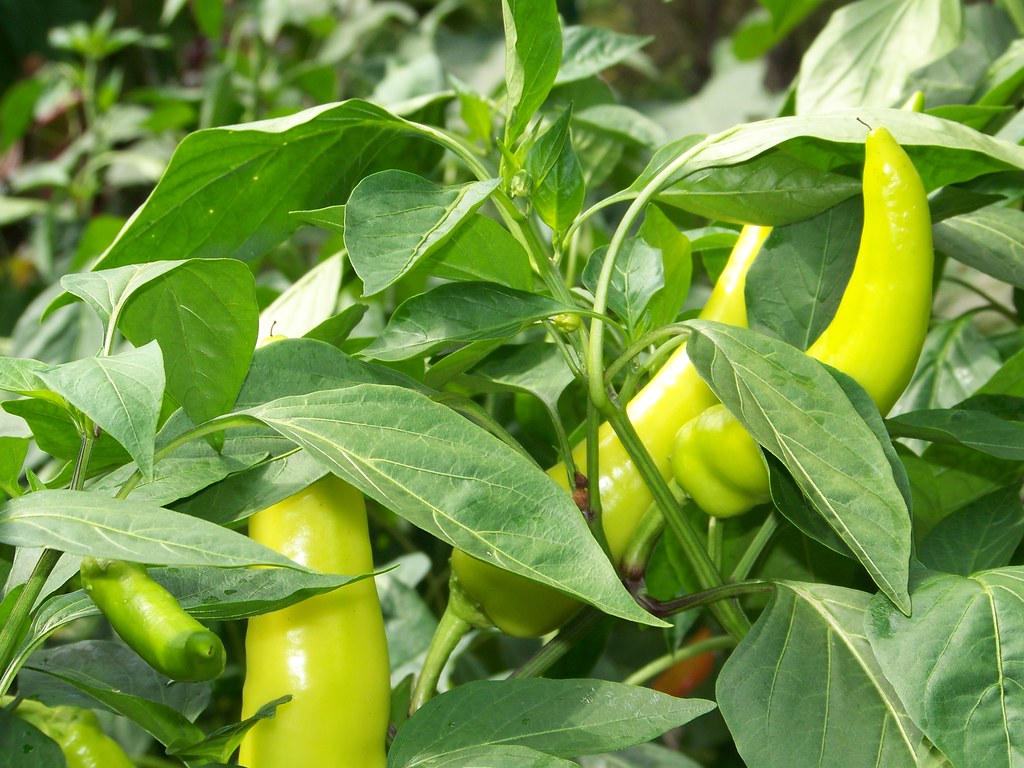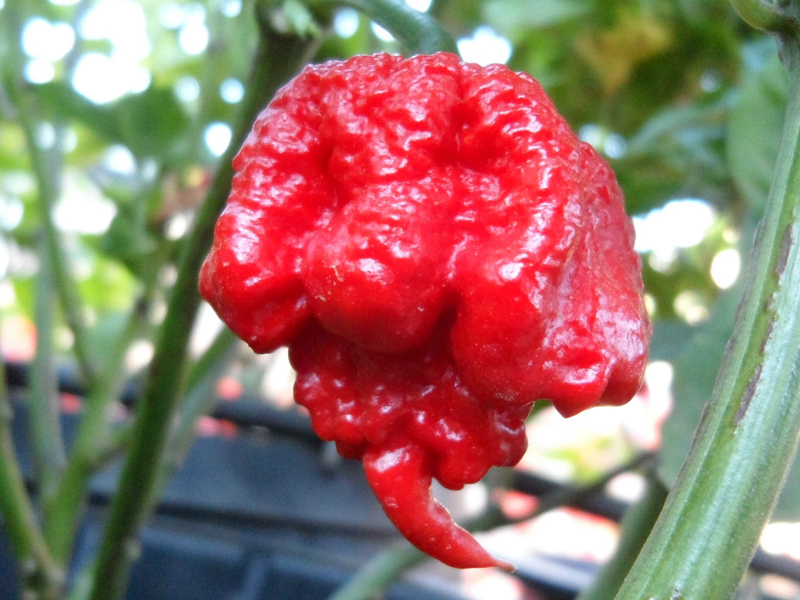When growing a salsa garden, you have a lot of choices when it comes to what kinds of peppers to use. What you will find as you grow more peppers is that there are thousands of different pepper varieties of varying levels of heat, colors, flavors, shapes, and sizes.
Since everyone has different levels of heat tolerance, the 14 (and more) recommended varieties are categorized based on 5 levels of heat, from sweet to super hot.
The heat level of chili peppers is measured in Scoville heat units (SHU), but for comparison purposes and to break down this abstract number and give you an idea of the relative heat, jalapenos (2,500-8,000 SHU), cayennes (30,000-50,000 SHU), Thai peppers (50,000-100,000 SHU), and habaneros (100,000-350,000 SHU) are used as reference peppers throughout this list.
| Pepper | Heat Level (SHU) |
|---|---|
| California Wonder (Bell) | 0 to 100 (heatless) |
| Nadapeno (No-Heat Jalapeno) | 0 to 100 (heatless) |
| Habanada (No-Heat Habanero) | 0 to 100 (heatless) |
| Anaheim | 500 to 2,500 |
| Poblano/Ancho | 1,000 to 2,000 |
| Jalapeno | 2,500 to 8,000 |
| Hungarian Hot Wax | 5,000 to 15,000 |
| Serrano | 10,000 to 23,000 |
| Cayenne | 30,000 to 50,000 |
| Thai Dragon | 50,000 to 100,000 |
| Habanero (Orange/Red) | 100,000 to 350,000 |
| Scotch Bonnet (Yellow) | 100,000 to 350,000 |
| Ghost Pepper / Bhut Jolokia | 855,000 to 1,000,000 |
| Carolina Reaper | 1.4 million to 2.2 million |
On this page:
Level 1 – Sweet Peppers
If you want to add peppers to your salsa but no heat, there are a few that stand out. All of these have approximately 0 SHU, meaning no heat, although rarely there may be virtually imperceptible heat in these peppers.
Other great sweet peppers to try: Lipstick, Jimmy Nardello, King of the North, Sweet Banana, Lunchbox, Ajvarski, Albino Bull Nose, Cubanelle, Marconi, Carmen
California Wonder (Bell)
A large bell pepper for market growers and home gardeners alike
Species: Capsicum annuum
Days to Maturity: 70 to 85 days
Height: 18 to 24 inches
Heat Level: 0 to 100 SHU (not even a trace of heat 99.9% of the time)
Get seeds: Baker Creek (US), Burpee (US), Park Seed (US), High Mowing Seeds (US), Urban Farmer Seeds (US), West Coast Seeds (Canada), McKenzie Seeds (Canada)
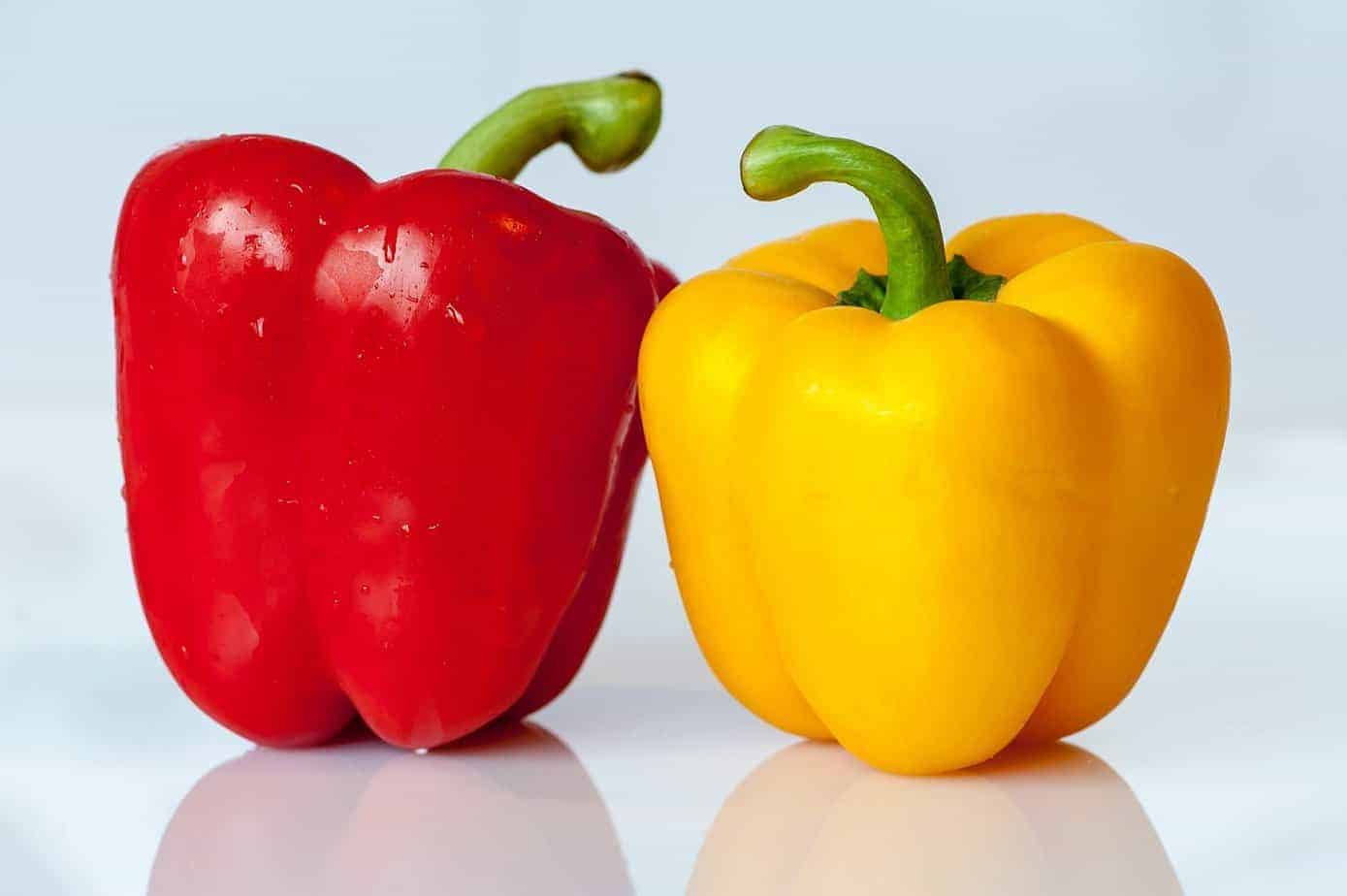
The California Wonder pepper is an old heirloom that sets the standard for bell peppers. These peppers have thick, juicy walls, good flavor when green, and if you let them ripen, they’re incredibly sweet when red. You may need to plant more since it will be hard to resist just snacking on them.
As with most peppers, the California Wonder ripens red, but it comes in yellow (Baker Creek, High Mowing Seeds, McKenzie Seeds[Canada]) as well.
Since it’s a very popular variety, you can find seeds easily online (see above) and can often get California Wonder plant starts at your local nursery in spring.
Nadapeno (No-Heat Jalapeno)
Enjoy the same jalapeno flavor without any heat
Species: Capsicum annuum
Days to Maturity: 65 to 75 days
Height: up to 36 inches
Heat Level: 0 to 100 SHU (not even a trace of heat 99.9% of the time)
Get seeds: Baker Creek (US), Seed Savers Exchange (US)
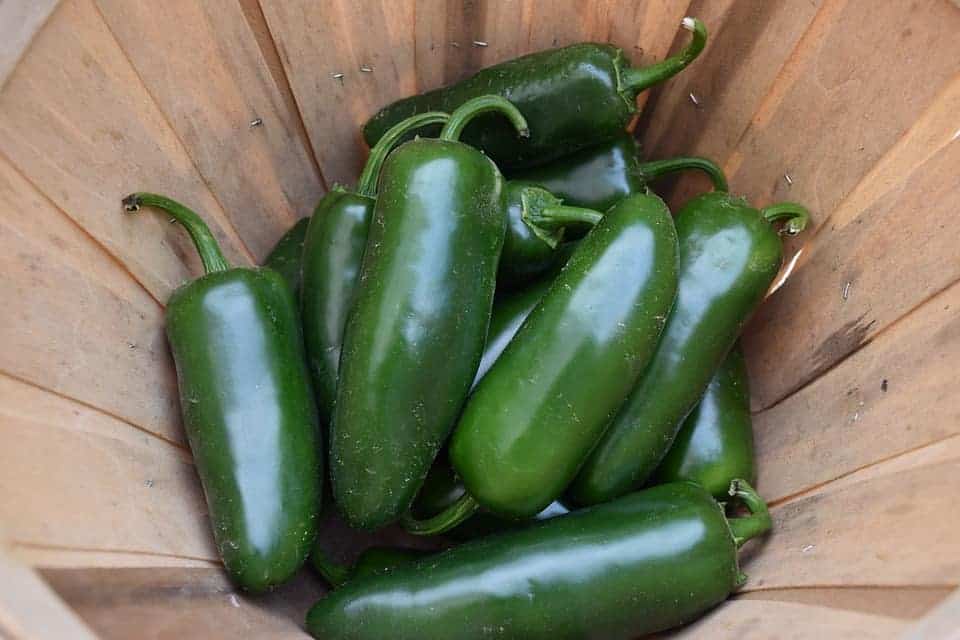
If you love the taste and aroma of jalapenos but want something mild, the Nadapeno was specifically bred to have the same flavor but without any heat. This is a relatively new type of jalapeno, but it’s quickly becoming popular due to the need for milder jalapeno varieties.
This variety grows exactly like other jalapenos, reaching 2 to 3 feet on average in a semi-bush growth habit, and producing dozens of peppers.
One interesting way to use this in your salsa is to mix it half and half with regular jalapenos so you can enjoy the taste of jalapenos in your salsa with half the heat. Or you can go full Nadapeno and make a heat-free salsa that’s still full of flavor. Highly recommended.
Habanada (No-Heat Habanero)
Habanero flavor and aroma without the heat
Species: Capsicum chinense
Days to Maturity: 100 days
Height: up to 36 inches
Heat Level: 0 to 100 SHU (not even a trace of heat 99.9% of the time)
Get seeds: Baker Creek (US), Fruition Seeds (US), Burpee (US), Territorial Seeds (US), Refining Fire Chiles (US), The Hippy Seed Company (Australia)
The Habanada is to habaneros as the Nadapeno is to jalapenos. It has the exact same tropical fruity aroma and flavor of a habanero but there is no heat. If you’ve ever had the (dis)pleasure of eating habaneros raw, you will flinch and wince when you bite into a Habanada, expecting the same heat, but you won’t feel even a tingle.
While they are edible green (ready in around 70 days after transplanting), they reach peak sweetness when completely ripe, when they turn into a bright tangerine orange color.
Great for salsas, salads, or just eating fresh out of the garden.
Level 2 – Mild Peppers
If you want heat in your salsa but don’t want to burn your face off, there are a lot of different peppers to try, including different types of jalapenos.
Other good mild peppers to try: Santa Fe Grande, Orange Spice Jalapeno, Peppadew, Mammoth Jalapeno, Sandia, Guajillo, Fresno
Anaheim
Massive, crunchy, mild peppers that add a gentle kick to salsas
Species: Capsicum annuum
Days to Maturity: 70 to 90 days
Height: 18 to 36 inches
Heat Level: 500 to 2,500 SHU (super mild up to a very mild jalapeno)
Get seeds: Baker Creek (US), Burpee (US), Urban Farmer Seeds (US), West Coast Seeds (Canada), Incredible Seeds (Canada)
The Anaheim is a classic pepper for salsas. It has medium-thick walls that are very crunchy, and a good kick of heat. For those who are used to eating jalapenos, the Anaheim is often much milder but occasionally gets up to mild jalapeno levels.
Anaheim pepper plants are bushy, sometimes reaching 3 feet tall, and are quite productive, producing lots of large, 6+ inch tapered peppers.
Not only are Anaheims perfect for salsas, but they’re also great fried, roasted, stuffed, or smoked.
Poblano (Ancho)
An amazing Mexican roasting pepper which adds texture, heat, and flavor to salsas
Species: Capsicum annuum
Days to Maturity: 70 to 80 days
Height: up to 30 inches
Heat Level: 1,000 to 2,000 SHU (half as hot to equal to a very mild jalapeno)
Get seeds: Baker Creek (US), Burpee (US), Sandia Seed (US), West Coast Seeds (Canada)
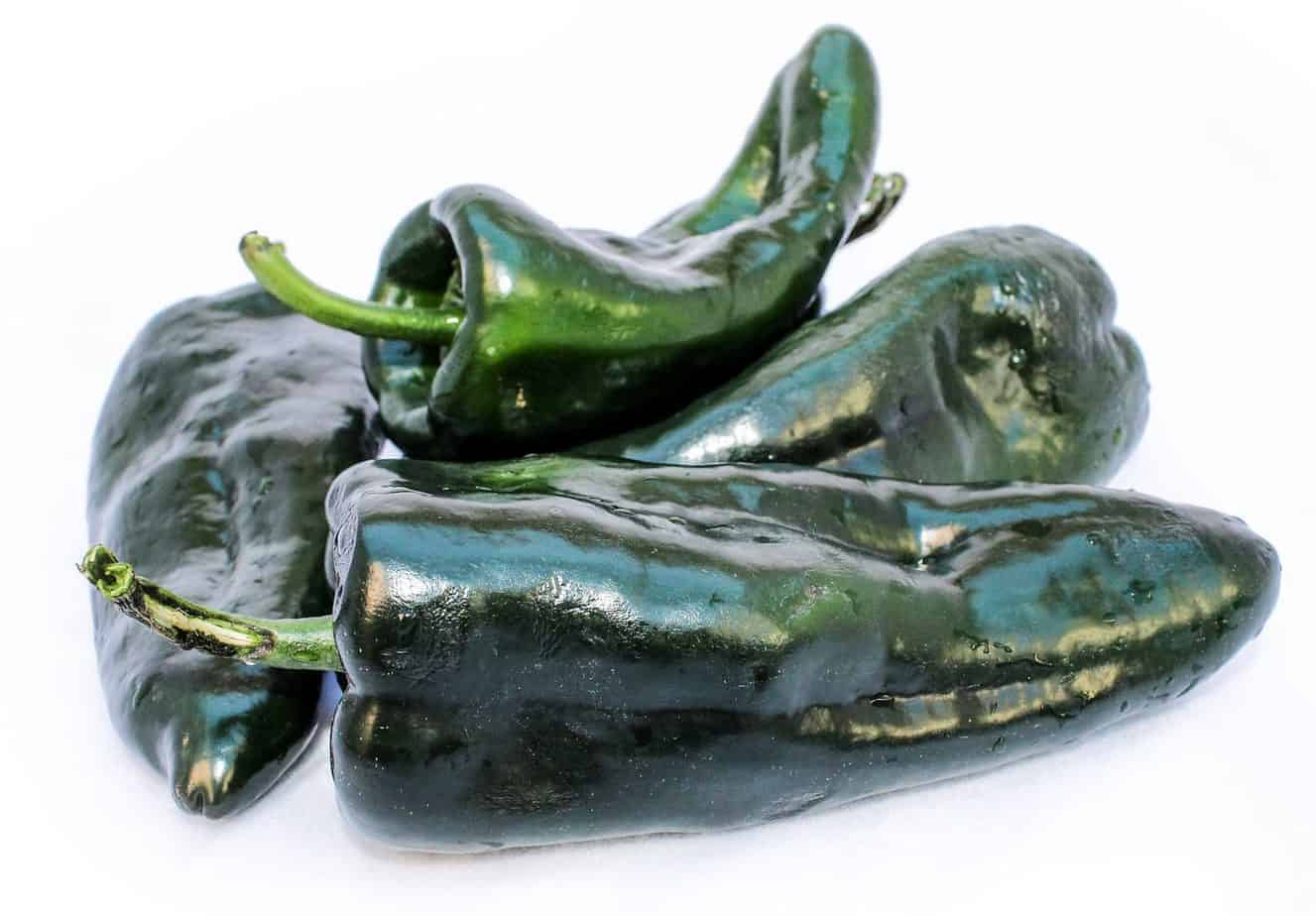
The Poblano pepper (sometimes called Ancho or Ancho Poblano) is a large, heart-shaped pepper that is renowned in Mexican cuisine and has recently become more popular in the US and around the world. It’s relatively mild, up to a mild jalapeno in heat, but gets much hotter as it ripens.
Unripe, Poblano peppers are glossy and dark green and super crunchy. If you can handle the heat, they make a nice addition to salads, but they really shine in salsa, chili, roasted, or stuffed.
Jalapeno (M, Early, Craig’s Grande, and Zapotec)
No need for introductions; it’s THE hot pepper for many people around the world
Species: Capsicum annuum
Days to Maturity: 70 to 80 days
Height: up to 18 inches
Heat Level: 2,500 to 8,000 SHU
Get Jalapeno M seeds: Sandia Seed (US), Harris Seeds (US), Park Seed (US), West Coast Seeds (Canada)
Get Early Jalapeno seeds: Johnny’s Selected Seeds (US), Burpee (US)
Get Craig’s Grande Jalapeno seeds: Baker Creek (US), Trade Winds Fruit (US)
Get Zapotec Jalapeno seeds: Baker Creek (US), Refining Fire Chiles (US), Fatalii Seeds (EU)
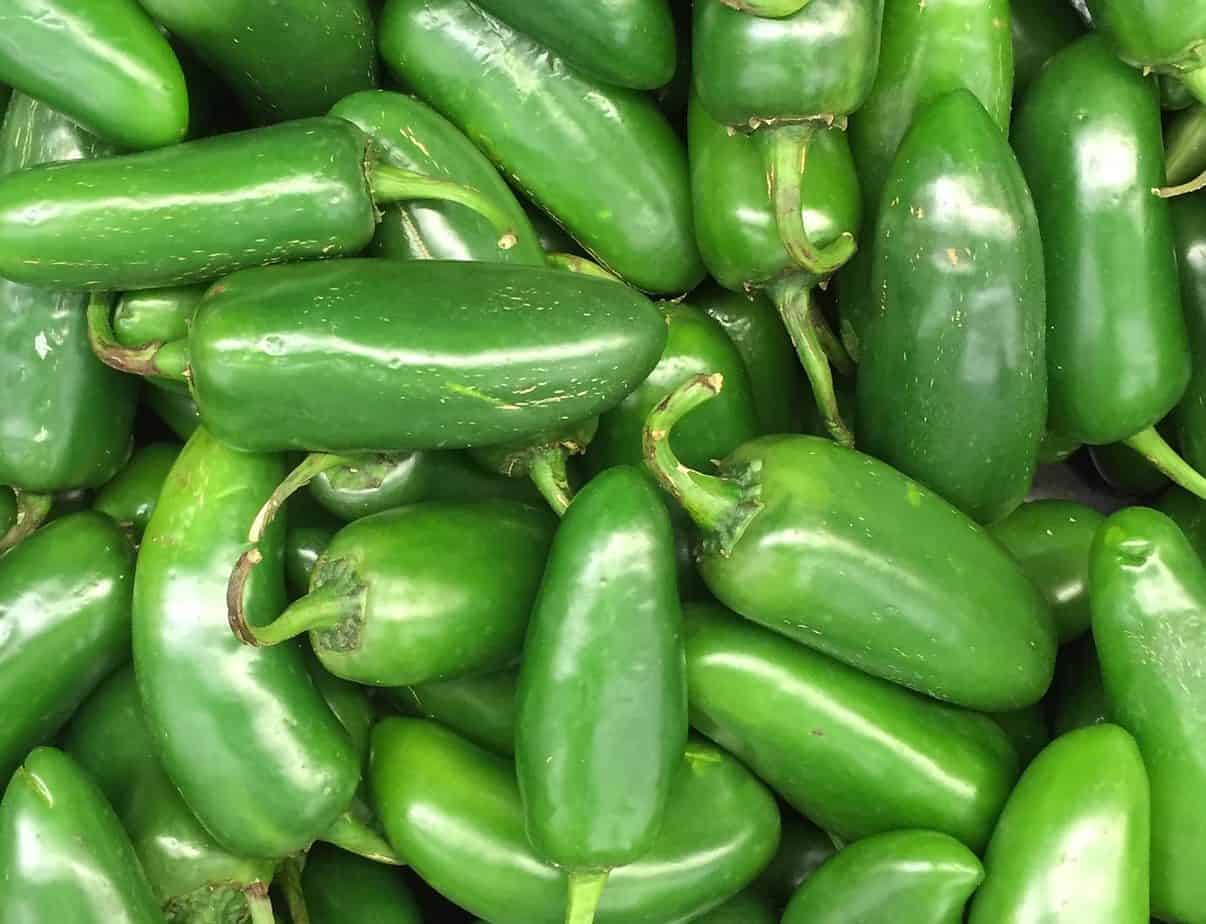
The Jalapeno is by far the most popular hot pepper in North America and one of the most popular around the world, and for good reason: it has decent heat and incredible taste and aroma. They are mostly sold green, but they ripen to a bright red and taste very sweet when mature.
Because there are so many types of jalapenos out there, I cannot recommend just one variety. However, there are four I would say are good places to start. The Jalapeno M is your standard, middle-of-the-road jalapeno with moderate heat. The Early Jalapeno is a similar variety, but as the name suggests, it produces peppers earlier than other varieties. Craig’s Grande Jalapeno is a fat jalapeno that’s as good for stuffing as it is for salsas. Lastly, the Zapotec Jalapeno is a hotter (closer to the 8,000 SHU level) jalapeno that’s very flavorful.
Jalapenos produce all season long, and the more you pick, the more they produce.
Level 3 – Hot Peppers
While experienced chili heads might debate whether jalapenos are mild or just sweet, this level is definitely in hot pepper territory. This is also where you will find a lot of diversity in flavors, shapes, and colors.
Other good hot peppers to try: Zia Pueblo, Large Red Thick Cayenne, Aji Pineapple, Aji Amarillo, Tabasco, Lemon Drop, Hot Portugal, Fish Pepper
Hungarian Hot Wax
The banana pepper’s much hotter cousin
Species: Capsicum annuum
Days to Maturity: 70 days
Height: up to 36 inches
Heat Level: 5,000 to 15,000 SHU (from jalapeno heat up to twice the average jalapeno heat)
Get seeds: Baker Creek (US), Burpee (US), Johnny’s Selected Seeds (US), West Coast Seeds (Canada)
It’s easy to mistake the Hungarian Hot Wax pepper for a banana pepper, which looks almost identical with its pale yellow color and long, tapered shape, but it’s much, much spicier. If grown in enough space in-ground or in a large enough container (5 gallons recommended) and fertilized well, even two or three plants will produce more than what most gardeners will eat.
With the Hungarian Hot Wax pepper, expect heat to be at least equivalent to a jalapeno, if not more. These peppers turn red when ripe, making them extra sweet, but also much hotter.
In addition to being used in salsa, these peppers make excellent frying peppers, are great pickled as hot pepper rings, or cut into a spicy salad.
Serrano
Very productive plants with fruits similar to jalapenos but thinner and with much more heat
Species: Capsicum annuum
Days to Maturity: 75 to 90 days
Height: up to 24 inches
Heat Level: 10,000 to 23,000 SHU (up to 3 times hotter than a jalapeno)
Get seeds: Baker Creek (US), Burpee (US), Urban Farmer Seeds (US), Incredible Seeds (Canada), OSC Seeds (Canada)
Harvested from bushy, compact pepper plants, Serrano peppers are very similar to jalapenos and can often be substituted for them in dishes. However, they are up to 3 times hotter. The flavor is very similar to jalapenos, although more people tend to like the taste of jalapenos more.
These are very productive plants, producing loads of finger-sized peppers. If you want to spice up a salsa, serranos will boost the heat of your salsa while not changing the flavor. A lot of the hotter peppers down this list will change the flavor with their fruity or floral notes.
Cayenne (Long Type)
A classic hot pepper that is great fresh as well as dried
Species: Capsicum annuum
Days to Maturity: 60 to 80 days
Height: up to 30 inches
Heat Level: 30,000 to 50,000 SHU (at least 4 times hotter than a jalapeno up to more than 10 times hotter)
Get seeds: Baker Creek (US), Johnny’s Selected Seeds (US), Burpee (US), OSC Seeds (Canada), Fatalii Seeds (EU)
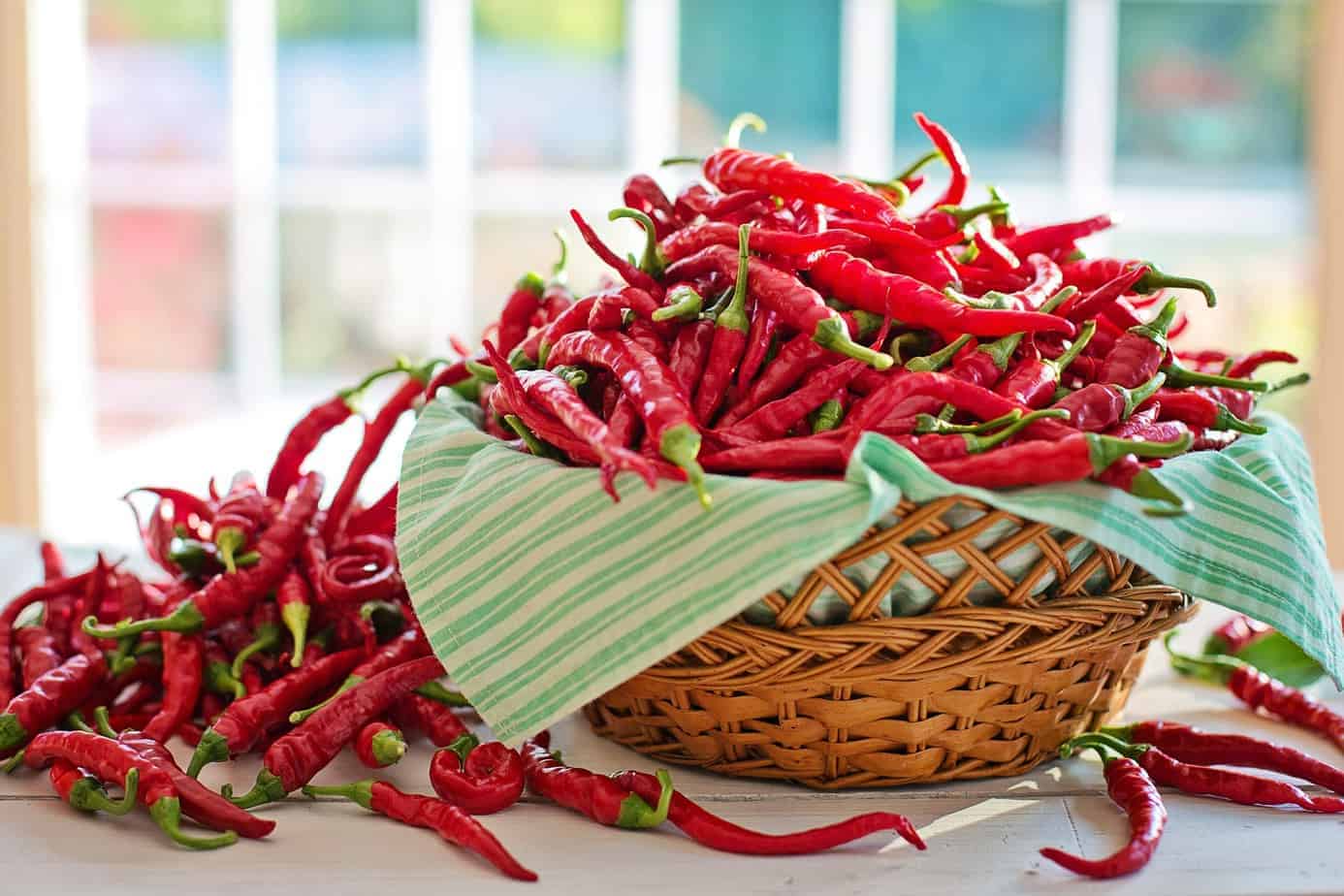
If you’ve only ever used Cayenne peppers for powder, you’re missing out on all the other uses of them. They make a great fresh pepper for spicing up salsas, and they are tasty even when harvested green. In fact, you can use unripe cayennes as a lower heat substitute for hotter Thai and Korean peppers.
Cayennes come in different sizes, shapes, and colors, but all have around the same heat, topping out at 50,000 SHU. The seed links above are for the long, thin type which are most common.
Cayenne pepper plants can be quite prolific, and even give decent harvests in smaller containers (but I still recommend at least 3 to 5 gallons for best results).
Level 4 – Very Hot Peppers
Level 4 is for those who want something really hot but don’t want to dive into the superhots yet. Here you will find habaneros, Scotch Bonnets, and other similar peppers, as well as Asian chilis and rocotos.
Other good very hot peppers to try: Rocoto/Manzano, Siling Labuyo, Datil, Fatalii, Devil’s Tongue, Bahamian Goat, Sugar Rush Peach, Chocolate Habanero, Red Savina Habanero
Thai Dragon
Compact, prolific plant that will definitely kick your salsa up a few notches
Species: Capsicum annuum or C. frutescens
Days to Maturity: 70 to 85 days
Height: up to 18 inches
Heat Level: 50,000 to 100,000 SHU (up to twice as hot as the hottest cayennes)
Get seeds: Refining Fire Chiles (US), Wildrose Heritage Seed Co. (Canada), Fatalii Seeds (EU)
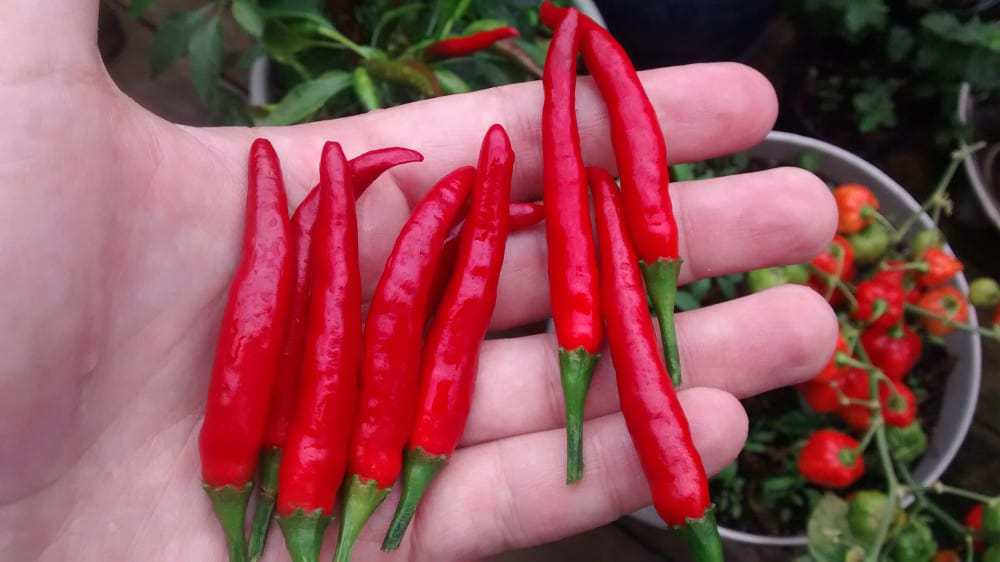
Thai peppers, especially the Thai Dragon, are the doorway to the really hot peppers. These small pods pack in a lot of heat, even for people who love spicy food.
Thai Dragons can be picked green or red, but note that the peppers do tend to dry quickly once ripe, so if you want to eat them fresh, pick them before they are fully ripe or right after they’ve fully ripened.
The Thai Dragon, without a doubt, is the one of the easiest pepper plants to grow on this list. It’s resilient, can take some neglect, and will produce peppers even in a smaller pot. Treat your Thai Dragon pepper plant well and you will be rewarded with more peppers than you can eat.
Chop them up and add them to your salsas to add a serious kick without changing the flavor.
Habanero (Orange/Red)
Highly productive plants with fruity, floral peppers with a high amount of heat
Species: Capsicum chinense
Days to Maturity: 90 to 100 days
Height: 36+ inches
Heat Level: 100,000 to 350,000 SHU (40 to 140 times hotter than a jalapeno)
Get Orange Habanero seeds: Burpee (US), Johnny’s Selected Seeds (US), Urban Farmer Seeds (US), Sandia Seed (US), Fatalii Seeds (EU)
Get Red Habanero seeds: Burpee (US), Baker Creek (US), Sandia Seed (US), West Coast Seeds (Canada)
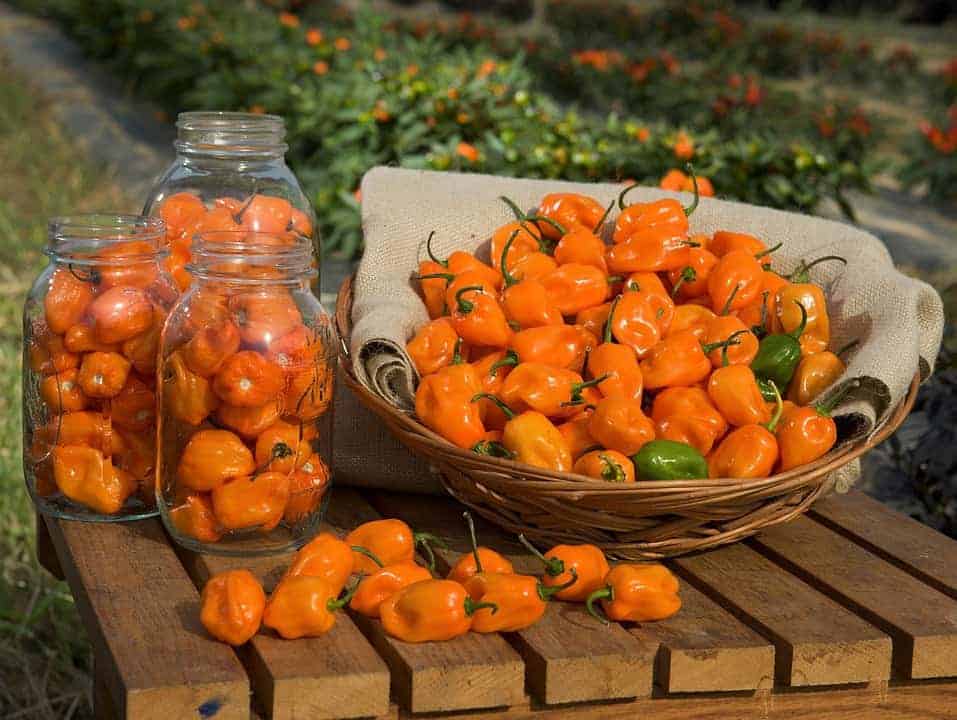
Habaneros are a different type of pepper than what was previously described. They have a lot of heat, of course, but they also have a unique fruity and floral taste and aroma that will give your salsa a different flavor profile.
Even the heat is different. While a jalapeno or a Thai Dragon produces an instant stinging burn, habaneros build up the burn over several seconds. When used in small amounts in salsa (such as sprinkling some dried habanero powder), the burn feels like a tingle in your whole mouth rather than a sting.
The two common varieties of habaneros ripen to either orange (the classic habanero) or red. However, there are now many varieties of habaneros, including chocolate brown, bright yellow, mustard yellow, and even white.
In the garden, habaneros are prolific producers, giving you tons of pods off one plant. Unless you are a chili head an love eating really hot stuff, one plant is often more than enough. Keep in mind that habaneros require a longer growing season to get ripe peppers.
If you love the flavor of habaneros but the heat is too much for your salsa, use Habanada peppers instead, which have the same taste but without any heat.
Scotch Bonnet (Yellow)
Similar to a habanero but more fruity than floral
Species: Capsicum chinense
Days to Maturity: 90 to 100 days
Height: 36+ inches
Heat Level: 100,000 to 350,000 SHU (roughly equivalent to a habanero)
Get seeds: Baker Creek (US), Sandia Seed (US), West Coast Seeds (Canada)
The Scotch Bonnet is similar to the habanero in a lot of ways. They have similar size and shape (although Scotch Bonnets usually have wider shoulders) and they share similar heat levels, which is scorching hot. However, Scotch Bonnets have a more fruity aroma and flavor than habaneros, the latter of which has more of a mix of fruity and floral.
Scotch Bonnets come in different colors, but the most common colors are yellow, orange, or red, with yellow being the classic Scotch Bonnet color. There are also other C. chinense varieties that are very similar, like the Bahamian Goat.
In the garden, treat Scotch Bonnets the way you would habaneros. They are both bushy, highly prolific plants that can easily reach 3 feet or more in height if given enough space.
Level 5 – Super Hot
For most chili pepper aficionados, anything above 1,000,000 SHU is considered a super hot pepper. Despite being a niche category, at this level there are hundreds of varieties and crosses to try in varying colors. You will notice that most of these have a similar aroma and flavor profile as habaneros and Scotch Bonnets, but with facemelting heat.
Other good super hot peppers to try (if you’re insane): Apocalypse Scorpion, 7 Pot Primo, Naga Viper, Dorset Naga, Trinidad Scorpion, Dragon’s Breath, Komodo Dragon, 7 Pot Brain Strain, 7 Pot Bubblegum, Peach Bhut Jolokia
Ghost Pepper / Bhut Jolokia
The flaming gate to superhots with plants that produce prolific amounts of highly aromatic, soul-burning peppers
Species: Capsicum chinense
Days to Maturity: 100 to 120 days
Height: 36 to 48+ inches
Heat Level: 855,000 to 1,000,000 SHU (nearly 3 times hotter than the hottest habanero, 10 times hotter than the hottest Thai Dragon, 20 times hotter than the hottest cayenne, and 125 times hotter than the hottest jalapeno)
Get seeds: Sandia Seed (US), Baker Creek (US), Urban Farmer Seeds (US), Refining Fire Chiles (US), West Coast Seeds (Canada)
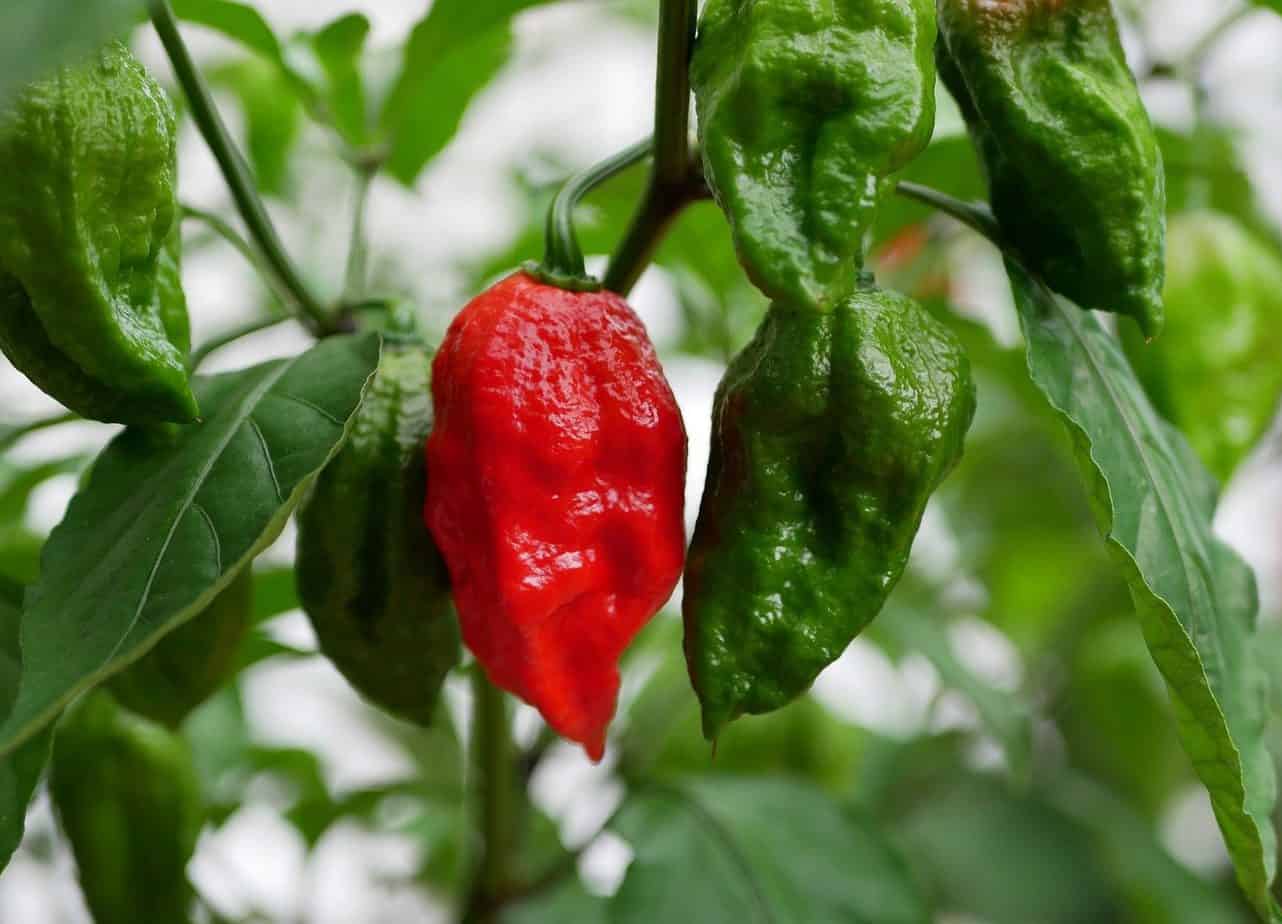
The Ghost Pepper, also known as the Bhut Jolokia, is a former world champion that still has enough heat to knock out experienced chili lovers. Despite the extreme heat, the Ghost pepper is very flavorful and its powerful floral aroma is instantly detectable once you cut into one.
Ghost pepper plants can grow very tall, in some cases reaching over 4 feet if given a large pot. They are also very productive, with large, mature plants yielding up to 100 peppers easily. The downside is the very long wait for ripe peppers.
You can certainly use Ghost peppers fresh in salsa, but you can also dry your harvested Ghost peppers and make them into chili flakes or powder to spice up salsas over the winter. At least with Ghost pepper powder, you can dial up the heat to exactly where you want it. The burn is often described as a “creeper” because the burn starts off slow, taking a long time to build up to the peak heat.
Carolina Reaper
Former Guinness World Record holder for the hottest pepper in the world
Species: Capsicum chinense
Days to Maturity: 120+ days
Height: up to 18 inches
Heat Level: 1.4 million to 2.2 million SHU; 1.6 million average (200 to 600 times hotter than a jalapeno; 4.5 to 16 times hotter than a habanero)
Get seeds: Puckerbutt Pepper Company (US), Baker Creek (US), Urban Farmer Seeds (US), Atlantic Pepper Seeds (Canada), South Devon Chilli Farm (UK)
Until 2023, the Carolina Reaper was the hottest pepper in the world according to Guinness World Records, with its hottest pepper ever recorded at 2.2 million SHU. It has since been replaced by the Pepper X (2.69 million SHU) which does not have seeds available yet.
Despite this, the Carolina Reaper has a sweet, fruity taste and aroma, making it a great addition to salsa for those with a penchant for pain.
The peppers themselves are usually round with bumpy skin, and a long pointy stinger, but some Carolina Reapers look more like red habaneros or Ghost peppers, which is a scary prospect if you’re growing them together in your garden.



